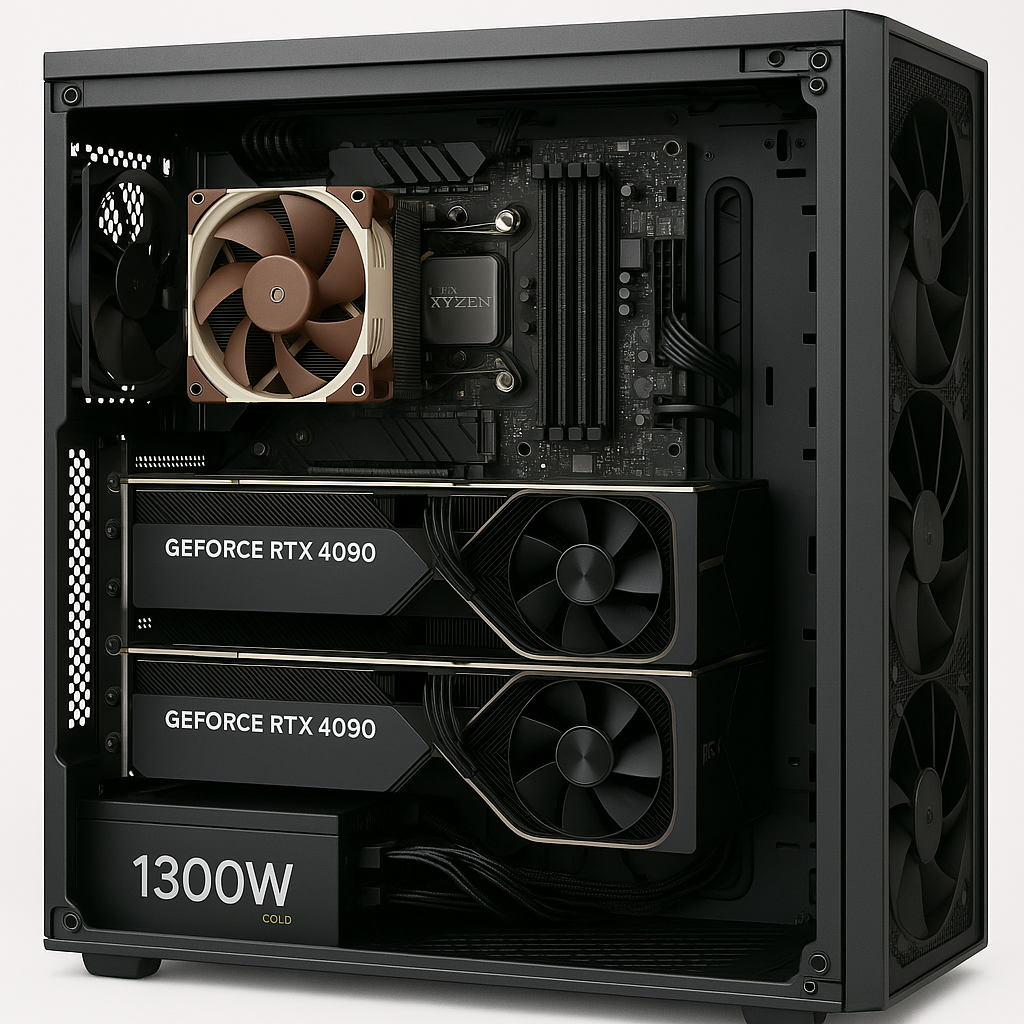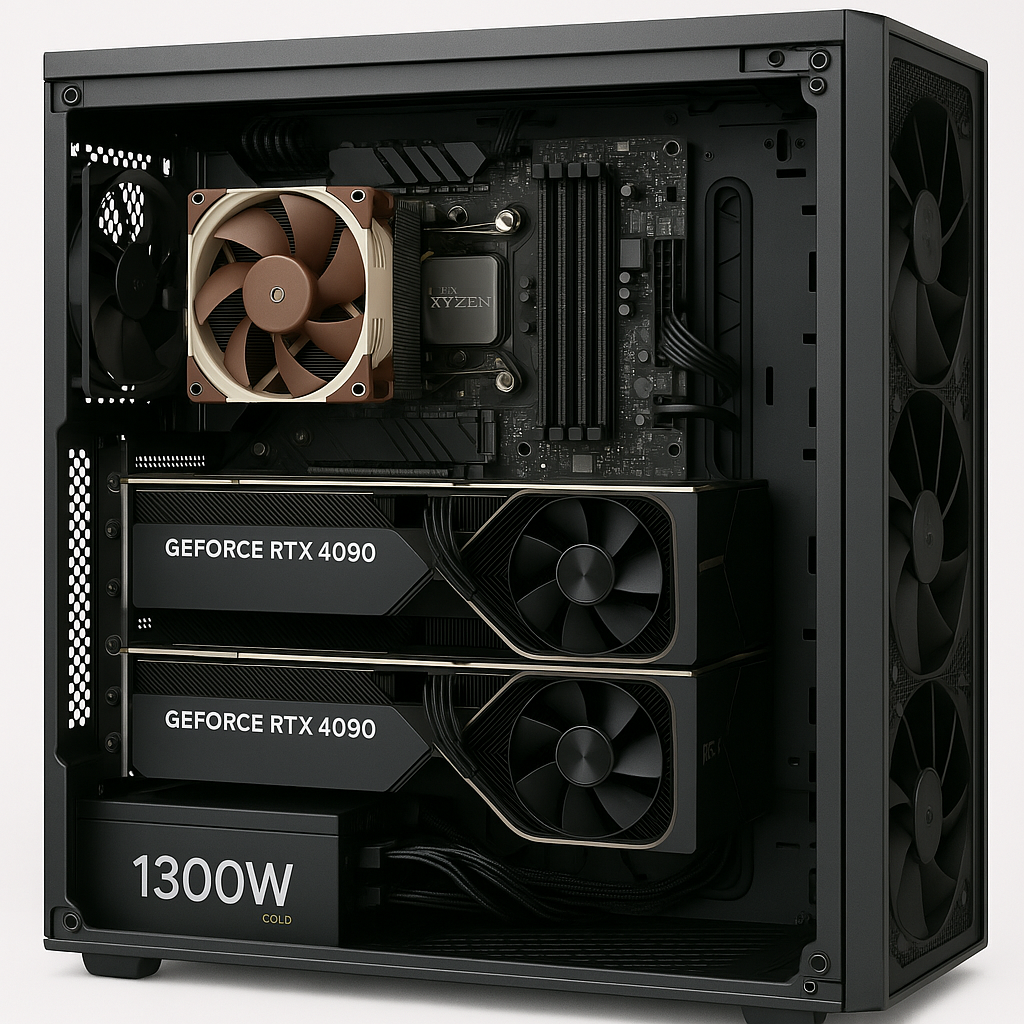sLLM or RAG AI Server 2X Nvidia Geforce RTX4090 Server
sLLM or RAG AI Server 2X Nvidia Geforce RTX4090 Server
1. Graphics Cards (GPUs):
-
2x NVIDIA GeForce RTX 4090 24GB GDDR6X
-
Reasoning: The core of the inference server. Two RTX 4090s offer 48GB of combined VRAM, allowing for the inference of larger models or batch processing for higher throughput. They provide excellent floating-point and Tensor Core performance at a significantly lower cost than professional data center GPUs like A100 or H100. Their high memory bandwidth (1008 GB/s per card) is crucial for quick data loading during inference.
-
Note: Ensure the motherboard has sufficient PCIe slots (preferably PCIe 4.0 x16 for both, or at least x8/x8 for optimal performance).
-
2. Processor (CPU):
-
AMD Ryzen 9 7900X or Intel Core i7-13700K / 14700K
-
Reasoning: For inference, the CPU primarily manages data loading, preprocessing, and orchestrating GPU tasks. A high-core-count, high-IPC (Instructions Per Cycle) CPU is beneficial but doesn't need to be top-tier server-grade. These consumer-grade CPUs offer excellent multi-threaded performance and single-core speed, which is sufficient for most inference pipelines. They also support PCIe 4.0 or 5.0, crucial for GPU communication.
-
Alternative (Cost-Effective): AMD Ryzen 7 7700X or Intel Core i5-13600K/14600K if budget is extremely tight, but the slightly higher core count of the Ryzen 9/Core i7 provides better headroom.
-
3. Motherboard:
-
AMD B650 or X670 (for Ryzen) / Intel Z790 (for Core i7/i9)
-
Key Features:
-
2x PCIe 4.0 x16 slots (physical x16, electrical x8/x8 or x16/x4 minimum): Essential for accommodating both RTX 4090s.
-
AM5 (AMD) or LGA 1700 (Intel) socket: Compatible with chosen CPU.
-
4x DDR5 DIMM slots: For future memory expansion.
-
Multiple M.2 NVMe slots (PCIe 4.0): For high-speed storage.
-
Strong VRM (Voltage Regulator Module): To handle the power delivery for the CPU and GPUs effectively.
-
Adequate spacing between PCIe slots: To allow for good airflow around the two large RTX 4090 cards.
-
-
4. System Memory (RAM):
-
64GB (2x 32GB) DDR5-6000MHz CL30 (or similar low-latency kit)
-
Reasoning: While GPU VRAM is paramount for model weights, system RAM is used for loading data, model quantization if needed, and intermediate processing. 64GB provides ample buffer for most inference workloads. DDR5 offers higher bandwidth than DDR4, which can benefit data transfer speeds to the GPUs. Low latency (CL30) is preferred for better overall system responsiveness.
-
Upgrade Option: 128GB (4x 32GB) if larger datasets or very complex pre/post-processing are anticipated, but 64GB is a good starting point for the budget.
-
5. Storage:
-
1TB NVMe PCIe Gen4 SSD (e.g., Samsung 970 EVO Plus, Crucial P5 Plus, WD Black SN770)
-
Reasoning: For the operating system, AI frameworks (PyTorch, TensorFlow), and frequently accessed models. PCIe Gen4 NVMe offers significantly faster load times compared to SATA SSDs, which is beneficial when loading large models or datasets.
-
Secondary Storage (Optional but Recommended): 2TB or 4TB SATA SSD if you need to store many different models or large datasets that don't fit on the primary NVMe drive. This is often more cost-effective than a larger NVMe for bulk storage.
-
6. Power Supply Unit (PSU):
-
1200W - 1300W 80 PLUS Gold/Platinum Certified (ATX 3.0 & PCIe 5.0 ready with 12VHPWR connectors)
-
Reasoning: Two RTX 4090s can consume significant power (up to 450W each, plus CPU, RAM, etc.). A high-wattage PSU with good efficiency (Gold/Platinum) ensures stable power delivery and longevity. Crucially, ensure it has at least two dedicated 12VHPWR (16-pin) connectors or comes with reliable adapters for the RTX 4090s. ATX 3.0 compliance is preferred for better transient power handling.
-
Brand Recommendation: Seasonic, Corsair, be quiet!, Cooler Master, EVGA.
-
7. Case:
-
Mid-Tower or Full-Tower ATX Case with Excellent Airflow
-
Key Features:
-
Spacious Interior: To accommodate two large RTX 4090s with adequate spacing for airflow.
-
Good Front/Top/Rear Fan Mounts: For optimal cooling.
-
Mesh Front Panel: For unrestricted air intake.
-
Support for large CPU air cooler or 240mm/360mm AIO liquid cooler.
-
-
Examples: Fractal Design Meshify 2, Lian Li Lancool III, Corsair 4000D Airflow, Phanteks P500A.
-
8. CPU Cooler:
-
High-Performance Air Cooler (e.g., Noctua NH-D15, DeepCool AK620, Thermalright Peerless Assassin 120 SE) or 240mm/280mm/360mm AIO Liquid Cooler
-
Reasoning: The chosen CPUs (especially Ryzen 9 or Core i7) can run hot under sustained load. An effective CPU cooler is vital for maintaining performance and system stability. Air coolers can be more cost-effective and reliable long-term.
-
9. Operating System (OS):
-
Ubuntu 22.04 LTS (or newer LTS version)
-
Reasoning: The de-facto standard for AI/deep learning development. Provides excellent driver support for NVIDIA GPUs (via CUDA Toolkit), and all major AI frameworks (PyTorch, TensorFlow, etc.) are optimized for Linux environments. Free to use.
-
Couldn't load pickup availability
Low stock: 1 left
View full details
